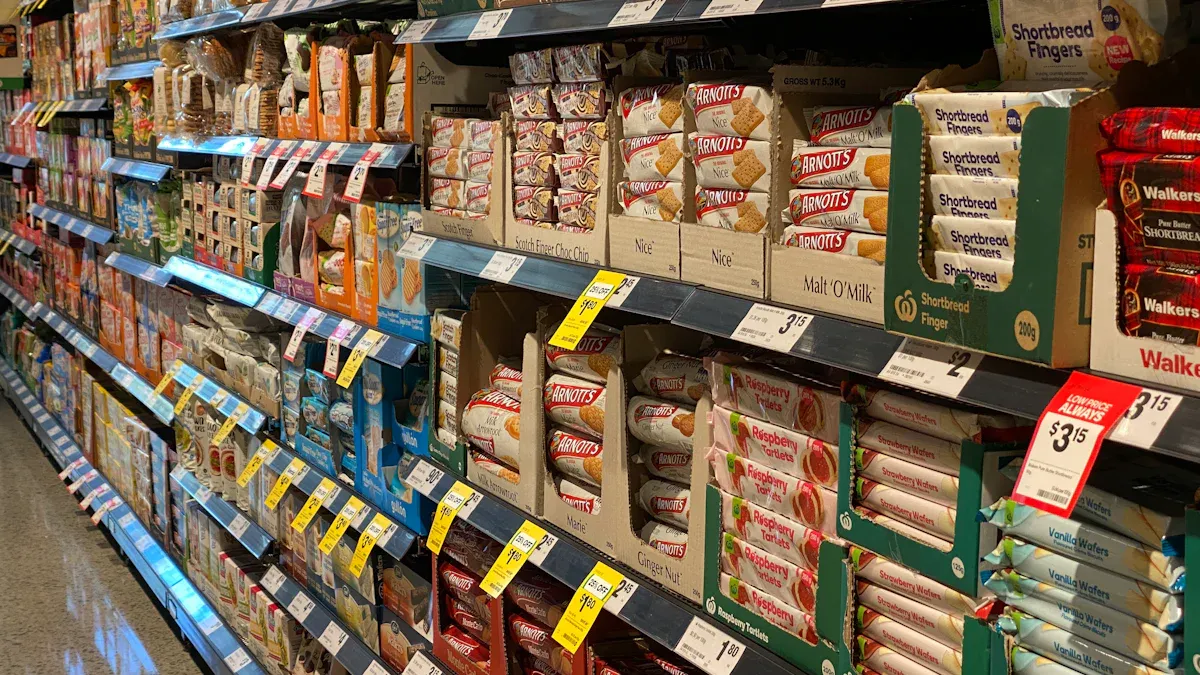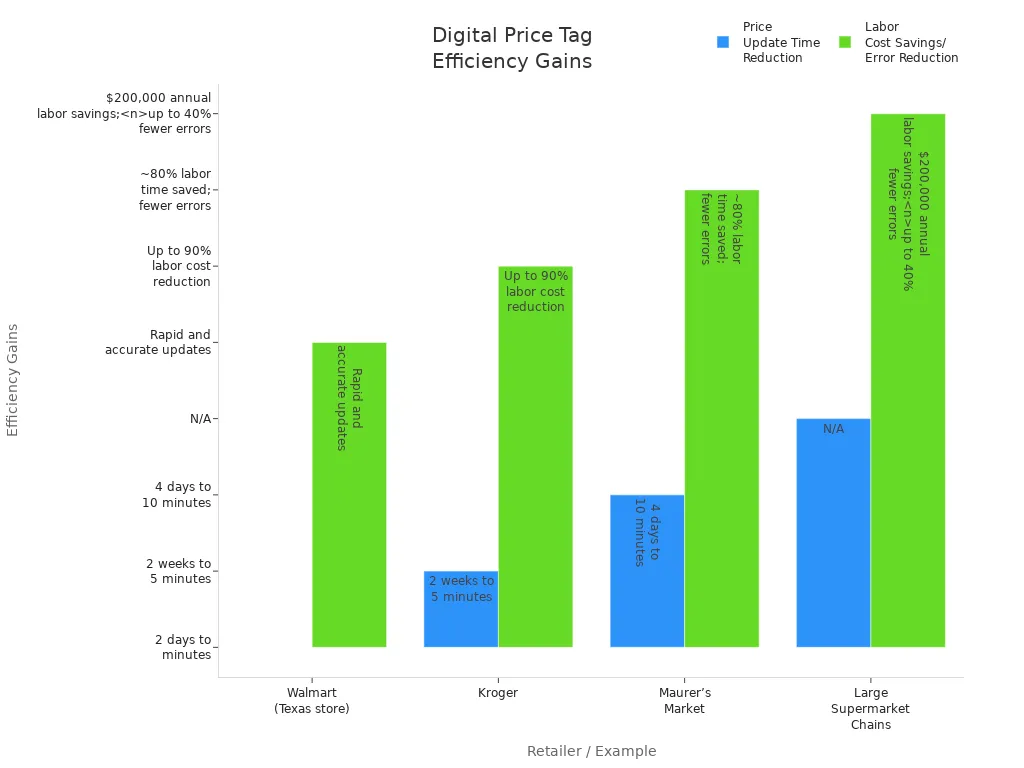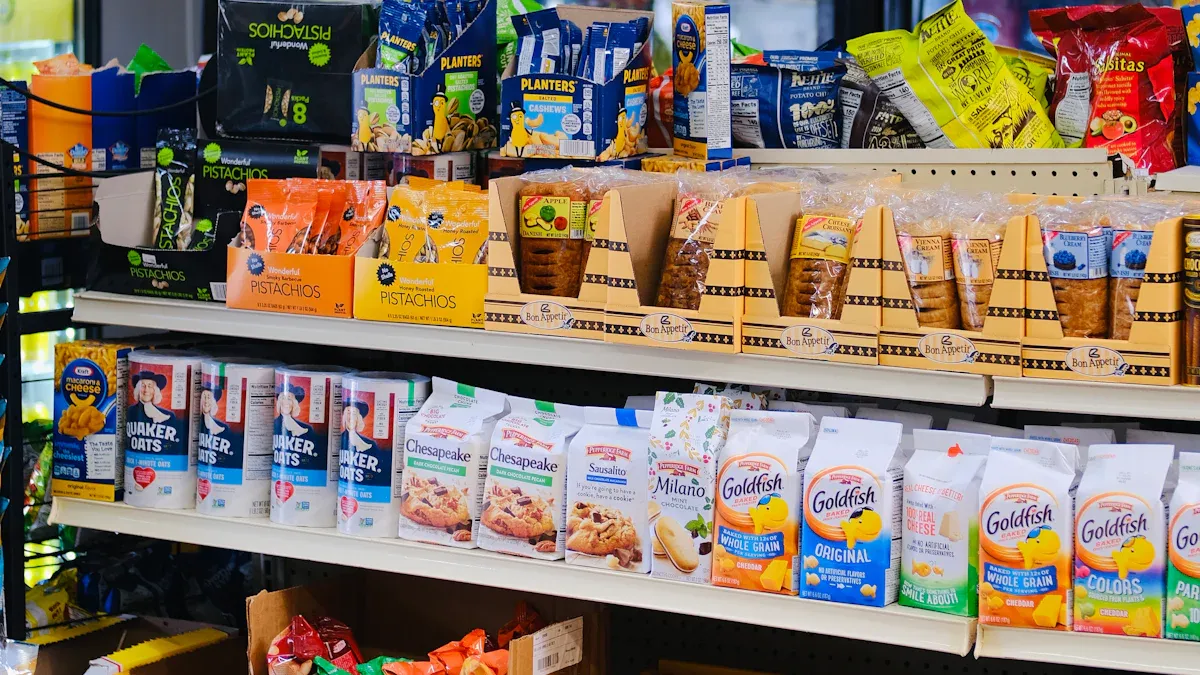
Walmart rolling out digital price tags to 2,300 stores marks a significant shift for the retail giant. By introducing Electronic Shelf Labels and ESL Price Tag technology, Walmart leverages Esl Retail innovation and the ESL Gateway AP system to improve price accuracy and speed. Studies indicate that price errors have dropped by 98%, and product return rates have decreased by 25%. While only 14% of shoppers report a positive impact, the transition allows employees to focus more on customer service, enhancing the overall in-store experience.
What Are Digital Price Tags at Walmart?

How Digital Price Tags Work in Stores
Electronic Shelf Labels and Real-Time Price Updates
Walmart uses electronic shelf labels to display prices and product information throughout its stores. These digital price tags use e-paper displays, which allow for clear visibility and low energy consumption. Employees no longer need to walk the aisles to replace paper tags. Instead, a centralized system updates prices instantly across thousands of products. This real-time update process ensures that the price on the shelf always matches the price at checkout. Shoppers see accurate, current pricing, which reduces confusion and disputes.
Note: Digital shelf labels can show more than just prices. They can display promotions, unit pricing, and even product attributes like allergy information or country of origin.
The table below highlights the main differences between digital price tags and traditional paper price tags:
| Feature/Aspect | Digital Price Tags (Walmart Example) | Traditional Paper Price Tags |
|---|---|---|
| Technology | E-paper displays, wireless updates | Printed paper, manual replacement |
| Update Process | Centralized, instant, remote updates | Manual, staff must replace tags |
| Information Displayed | Prices, promotions, product details | Product name and price only |
| Accuracy and Synchronization | Matches checkout prices, reduces errors | Prone to mismatches and errors |
| Labor and Efficiency | Reduces labor, streamlines operations | Labor-intensive, time-consuming |
| Customer Experience | Clear, current, transparent pricing | Outdated prices possible, less transparency |
| Sustainability | Low energy, less paper waste | Uses paper, frequent replacements |
| Reliability During Outages | E-paper retains last displayed price | Not applicable |
| Pricing Flexibility | Supports dynamic, scheduled pricing | No real-time or dynamic pricing |
Integration with Walmart’s Pricing Systems
Walmart integrates electronic shelf labels with its advanced pricing systems. The technology connects each digital tag to a central gateway. This setup allows the company to synchronize prices across all stores quickly. When Walmart updates a price in its system, the change appears on the shelf label within minutes. This integration reduces human error and ensures consistency between online and in-store prices. Employees can focus on customer service instead of manual price changes.
Technology Powering Digital Price Tags
Wireless Connectivity and Centralized Price Control
Walmart relies on enterprise-grade electronic shelf labels powered by e-ink or LCD technology. These labels connect wirelessly to a central gateway using secure, low-power communication protocols. The system supports real-time updates and can scale to thousands of labels in large stores. Centralized price control means that managers can adjust prices for promotions or inventory changes instantly, improving operational efficiency.
- Electronic shelf labels from providers like Vusion Group and Pricer offer robust wireless communication.
- The technology supports advanced features such as color-coded lighting and integration with services like Instacart’s Pick to Light.
- Battery life for these digital tags ranges from three to ten years, depending on how often prices change.
Security and Reliability of Price Displays
Walmart’s digital shelf labels use secure wireless networks to prevent unauthorized access. The e-paper displays retain the last shown price even during power outages, ensuring shoppers always see accurate information. The technology offers high reliability, with minimal maintenance required. Compared to simpler solutions, Walmart’s system provides better scalability and advanced integration with store operations. This approach helps maintain price accuracy and builds trust with customers.
Why Is Walmart Rolling Out Digital Price Tags?
Boosting Efficiency and Speed
Faster Price Changes Compared to Paper Tags
Walmart rolling out digital price tags to over 2,000 stores addresses a major challenge in retail: the time and labor required for manual price updates. Previously, employees needed to physically replace paper tags for each product, a process that could take up to two days for a single store. Now, with digital technology, price changes occur in seconds. Staff can update prices remotely and instantly, even multiple times a day. This shift saves hours of labor and allows employees to focus on customer service rather than repetitive tasks.
Streamlining Store Operations
Digital shelf labels do more than just speed up price changes. They streamline stock replenishment and order picking by signaling which shelves need attention. Employees receive real-time alerts, making it easier to keep shelves stocked and organized. The technology also provides data insights that help managers optimize sales, inventory, and store traffic. As a result, Walmart improves operational efficiency and reduces the risk of out-of-stock items.
Note: Walmart stores carry over 120,000 products, making manual price updates especially labor-intensive. Digital price tags eliminate this burden.
Enhancing Price Accuracy and Consistency
Reducing Human Error in Price Updates
Manual price updates often lead to mistakes, such as mismatched prices between shelves and checkout. Digital shelf labels automate this process, reducing human error and ensuring that prices remain accurate. Automated records of price changes provide transparency and traceability, allowing quick detection and correction of any issues.
Ensuring Consistent Prices Across Channels
Walmart rolling out digital price tags ensures that shelf prices always match checkout prices, both in-store and online. Real-time synchronization eliminates discrepancies that can cause customer complaints. The following table highlights efficiency gains across major retailers:
| Retailer / Example | Labor Savings / Efficiency Gains |
|---|---|
| Walmart (Texas store) | Price changes reduced from ~2 days to minutes, enabling rapid and accurate updates. |
| Kroger | Repricing time cut from 2 weeks to 5 minutes; up to 90% labor cost reduction. |
| Maurer’s Market | Price update time cut from 4 days to under 10 minutes; ~80% labor time saved; fewer errors. |
| Large Supermarket Chains | Annual labor cost savings of $200,000; up to 40% reduction in pricing errors. |

Staying Ahead in Retail Innovation
Responding to Industry Trends
Walmart leads the U.S. retail sector in adopting digital shelf labels. While European supermarkets have widely implemented this technology, only a small percentage of U.S. retailers have followed suit. Walmart’s large-scale investment positions it as a pioneer, setting a benchmark for operational efficiency and sustainability.
Setting New Standards for Competitiveness
By rolling out digital price tags, Walmart demonstrates a commitment to innovation and customer experience. The company’s partnership with leading technology providers introduces advanced features like automated pricing updates and enhanced inventory management. This move not only improves store operations but also sets new standards for competitiveness in the retail industry.
How Walmart’s Digital Price Tags Affect Shoppers

Price Accuracy and Transparency for Customers
Real-Time Price Adjustments
Digital price tags at Walmart synchronize shelf and register prices in real time. This technology eliminates mismatches between what customers see and what they pay. Recent case studies and customer feedback show that these tags improve price accuracy and transparency. Customers now experience fewer disputes at checkout, as the displayed price always matches the final charge. The system enables instant updates for promotions and discounts, making deals more visible and transparent. This approach builds trust, as shoppers know they pay exactly what the shelf shows. The technology also creates an audit trail, which enhances transparency and accountability for both customers and store management.
Fewer Pricing Mistakes at Checkout
- Digital price tags at Walmart synchronize shelf prices with checkout systems, reducing pricing errors.
- Integrated digital tags can reduce pricing errors by up to 100%, ensuring shelf prices always match checkout prices.
- Walmart associates can quickly verify and correct price discrepancies using digital tags, improving accuracy and customer trust.
- Automated records and system integration allow fast detection and correction of pricing mistakes.
- Walmart’s system encourages customers to report discrepancies, which are promptly resolved, further reducing checkout pricing errors.
Traditional price tags require manual updates, which often lead to outdated or missing tags and mismatched prices at checkout. Manual updates increase the risk of pricing errors and customer dissatisfaction. Digital price tags reduce manual pricing errors by approximately 60%, as reported by European supermarkets. Automated price adjustments with digital tags reduce labor costs and errors, improving operational efficiency. Digital tags also minimize the frequency of label replacements, indirectly supporting pricing accuracy by maintaining up-to-date information.
Shopping Convenience and Experience
Easier to Spot Deals and Promotions
Walmart’s digital price tags make it easier for customers to spot deals and promotions. Instant updates allow the store to highlight discounts and special offers as soon as they become available. Customers can quickly identify savings on grocery items and food prices, which enhances the shopping experience. The technology ensures that promotions are always current, reducing confusion about which products are on sale.
Clearer Product and Price Information
Customers benefit from richer product information displayed on digital tags. These labels can show not only the price but also product details, allergy information, and country of origin. The clear, up-to-date information helps shoppers make informed decisions, especially when comparing grocery store prices. The following table summarizes improvements in shopping convenience and customer experience since Walmart introduced digital price tags:
| Improvement Aspect | Description |
|---|---|
| Faster Price Updates | Price changes that previously took two days now take only minutes, enabling timely and accurate pricing. |
| Increased Associate Productivity | Reduced walking time and repetitive tasks allow associates to spend more time assisting customers. |
| Simplified Stock Replenishment | “Stock to Light” feature uses LED signals to quickly identify shelves needing restocking. |
| Faster Order Picking & Fulfillment | “Pick to Light” guides associates to products for online orders, speeding up the process and improving accuracy. |
| Enhanced Customer Experience | Clear, up-to-date pricing and better stocked shelves improve shopper satisfaction. |
| Sustainability Benefits | Digital labels reduce operational waste by eliminating paper tags. |
| Expansion Plans | Walmart plans to implement digital shelf labels in 2,300 stores by 2026, indicating broad impact. |
Tip: Lights on digital shelf labels help associates identify shelves that need restocking, which keeps products available for customers and improves the overall grocery shopping experience.
Addressing Concerns About Price Changes
Walmart’s Policy on Dynamic Pricing
Some customers and consumer advocates have expressed concerns that digital price tags could enable dynamic pricing or price gouging, especially for essential grocery items. U.S. Senators and other political figures have raised questions about the potential for sudden increases in prices based on time of day or demand. Walmart has responded by assuring the public that the electronic shelf labels will not be used to increase prices during the day. The company states that the technology’s purpose is to improve efficiency and reduce labor costs, not to implement surge pricing. Walmart emphasizes that digital price tags will only reflect lower prices for sales or clearance items, not higher prices.
What Shoppers Can Expect with Prices
Customers can expect greater consistency and transparency in online and in-store pricing. Walmart’s digital system ensures that prices remain stable throughout the day, except when reflecting legitimate sales or markdowns. The company’s approach aims to build trust and loyalty by providing clear information about grocery prices and food prices. While some skepticism remains, Walmart’s public commitment to fair pricing practices helps address concerns and sets expectations for how digital price tags will function in stores.
Benefits of Digital Price Tags for Walmart and Employees
Operational Improvements and Labor Savings
Reducing Manual Price Tag Updates
Digital price tags have transformed how Walmart manages pricing in its stores. Employees no longer spend hours replacing paper tags. Instead, they update prices instantly through a centralized system. This shift has cut the labor required for manual price updates by about half. The automation of price changes allows for rapid adjustments across thousands of products, which boosts productivity and operational efficiency.
“Walmart has said the digital labels will give workers ‘more time to support customers in the store.’”
The following table summarizes key operational improvements:
| Improvement Aspect | Description |
|---|---|
| Labor Savings | Walmart reduced manual price update labor by about half, cutting hours spent changing paper tags. |
| Employee Focus | Employees are freed from price tag duties to spend more time assisting customers. |
| Instant Price Updates | Prices can be updated instantly across thousands of stores, eliminating hours of manual work. |
| Integration with POS Systems | Digital price tags connected to POS improve transaction speed, accuracy, and inventory management. |
| Operational Efficiency | Automation streamlines store operations, reduces errors, and enhances pricing accuracy. |
| Sales Impact | Smoother price management has contributed to increased sales performance. |
Allowing Employees to Focus on Customer Service
With less time spent on repetitive tasks, employees can dedicate more attention to customer needs. This shift leads to increased productivity and a better in-store experience. Associates can help shoppers find grocery items, answer questions, and keep shelves organized. The result is a more responsive and helpful staff presence throughout the store.
Better Inventory and Store Management
Improved Stocking and Picking Efficiency
Walmart’s digital price tags include features that enhance inventory management. Employees use an app to update prices in minutes, saving valuable time. The LED Pick to Light feature guides associates to the correct shelf for inventory replenishment and online order picking. This technology improves accuracy and speed, which directly increases productivity and reduces errors in fulfilling grocery orders.
- Employees update prices in minutes via an app, replacing a manual process that previously took days.
- The Pick to Light feature illuminates shelf locations for inventory and order picking.
- This system reduces errors and streamlines inventory replenishment.
- Forrester analysts confirm labor cost savings and positive revenue impacts from this technology.
- Walmart piloted this system in Texas and plans to expand it to 2,300 stores by 2026.
Enhanced Store Organization
Digital price tags help maintain a well-organized store environment. The technology supports efficient stocking and picking, which keeps shelves full and products easy to find. Improved organization benefits both employees and customers, especially in busy grocery sections.
Environmental Impact of Digital Price Tags
Cutting Down on Paper Waste
Walmart’s adoption of digital price tags significantly reduces the need for paper price tags. This change minimizes operational waste and supports the company’s sustainability goals. By replacing traditional paper tags with digital displays, Walmart demonstrates a commitment to environmental responsibility.
Supporting Sustainable Store Operations
The shift to electronic shelf labels aligns with Walmart’s broader efforts to integrate environmental responsibility into its business practices. The technology not only reduces paper waste but also streamlines operations, indirectly supporting sustainability through increased efficiency.
Potential Challenges and Concerns with Digital Price Tags
Technical Issues and System Reliability
Handling Glitches and Outages
Digital price tag systems in Walmart stores depend on robust wireless networks and centralized software. This reliance introduces risks such as network outages or software glitches. When these issues occur, store operations can face disruptions. For example, if the wireless network fails, employees may not update prices promptly, leading to confusion at checkout. Although Walmart has not reported specific incidents, the possibility of technical problems highlights the need for strong infrastructure. Retailers must invest in reliable systems and backup solutions to ensure that prices remain accurate and visible to shoppers at all times.
Maintenance and Upkeep of Digital Tags
Maintaining thousands of digital tags across large stores presents ongoing challenges. Each tag requires periodic battery replacement and software updates. Regular maintenance ensures that the technology functions correctly and displays the right pricing information. Walmart must schedule routine checks and train staff to handle minor repairs or replacements. Proactive upkeep helps prevent display errors and extends the lifespan of the digital tags.
Shopper Concerns About Price Fluctuations
Addressing Fears of Sudden Price Changes
Some shoppers worry that digital price tags could enable sudden or unfair changes in prices. Concerns include the potential for price gouging during emergencies or peak shopping times. Walmart addresses these fears by publicly denying the use of dynamic or surge pricing, even though the technology could support such practices. The company states that its business model focuses on lowering prices to attract customers, not raising them unexpectedly.
| Aspect | Details |
|---|---|
| Technology Used | Electronic Shelf Labels (ESLs) enable instant, remote price updates across thousands of items, improving efficiency and accuracy while reducing manual labor and pricing errors. |
| Walmart’s Position on Pricing | Walmart denies using dynamic or surge pricing despite ESLs enabling such capabilities; emphasizes price lowering to attract customers. |
| Shopper Concerns | Potential for price gouging during emergencies or peak times, lack of transparency in pricing changes, and risk of discriminatory pricing based on shopper profiles. |
| Regulatory Oversight | State Attorneys General investigate unfair or deceptive pricing practices, demand transparency, enforce antitrust laws, protect consumer privacy, and advocate for consumers. |
| Fairness Policies | No explicit Walmart internal policies disclosed; fairness is primarily ensured through public denials of surge pricing and external regulatory scrutiny rather than detailed internal measures. |
Building Trust and Loyalty with Transparent Prices
Walmart builds trust by ensuring that prices remain stable and transparent. The company communicates its policies clearly and responds to public concerns. Regulatory agencies also monitor pricing practices to protect consumers. Transparency in how prices are set and displayed helps maintain shopper loyalty and confidence in the brand.
Privacy and Data Security Considerations
How Shopper Data Is Used
Digital price tag technology does not require the collection of personal shopper data to function. Walmart has publicly denied using facial recognition or tracking individual shoppers for pricing purposes. The system focuses on updating product prices efficiently, not on gathering or analyzing customer information.
Transparency in Pricing Technology
Walmart faces ongoing scrutiny from regulators and consumer advocates regarding privacy and fairness. The company must remain transparent about how its technology works and how it manages pricing. Clear communication and compliance with privacy laws help reassure shoppers that their data remains protected and that the technology serves to improve efficiency rather than exploit personal information.
Industry Impact of Walmart Rolling Out Digital Price Tags
Influence on Other Retailers and Market Trends
Will Competitors Adopt Digital Price Tags?
Walmart’s large-scale adoption of digital price tags has set a new benchmark for the industry. Other major retailers now face pressure to modernize their pricing systems to remain competitive. Many have started pilot programs or expanded their use of electronic shelf labels. Whole Foods Market, for example, has begun implementing similar technology in select locations. The trend is gaining momentum as retailers recognize the operational benefits.
- Digital price tags reduce labor costs by enabling remote price updates.
- Price update times have dropped from days to minutes, increasing store efficiency.
- The technology decreases pricing errors, which leads to fewer customer complaints and less lost revenue.
- Retailers can now adjust prices quickly in response to market conditions, such as weather-driven demand.
- Enhanced inventory tracking and faster e-commerce order fulfillment improve the omnichannel shopping experience.
Industry experts predict a surge in dynamic pricing strategies and operational efficiency gains. Fewer employees will need to handle manual price changes, allowing staff to focus on customer service and other value-added tasks.
Shaping the Future of Retail Pricing
Digital price tags have transformed how retailers approach pricing. Linked pricing systems eliminate discrepancies between shelf and checkout prices. The technology enables real-time updates for promotions and markdowns, supporting more agile pricing strategies. Some retailers have started to experiment with interactive features, such as QR codes and gamification, to engage shoppers and open new revenue streams.
Experts caution that dynamic pricing, while powerful, may attract regulatory scrutiny. The US Federal Trade Commission has begun investigating pricing practices, and political leaders have voiced concerns about potential price gouging. Retailers must balance innovation with transparency and fairness to maintain consumer trust.
The Evolution of In-Store Shopping Experiences
Blending Digital and Physical Retail
The integration of digital price tags marks a significant step in blending digital and physical retail environments. Walmart’s deployment of digital shelf labels in hundreds of stores has enabled faster and more accurate price updates. Associates spend less time on manual tasks and more time assisting customers. Accurate pricing and improved product availability enhance the overall shopping experience.
- Digital price tags contribute to a seamless omnichannel experience.
- Associates use digital tools, such as virtual assistants and real-time notifications, to improve customer convenience.
- The technology empowers employees and streamlines store operations.
Walmart’s approach reflects a people-led, tech-powered model that benefits both customers and staff.
What’s Next for Prices and Technology in Retail
Industry experts foresee continued evolution in pricing technology. Digital shelf tags will enable real-time updates of prices and product information. Integration with back-end systems will allow instant changes for promotions and faster restocking. Retailers plan to adopt additional technologies, such as computer vision for inventory management.
However, experts warn that dynamic pricing could lead to consumer backlash if not managed transparently. Most consumers remain wary of rapid price changes, viewing them as potential price gouging. Retailers must prioritize transparency and fairness as they innovate, ensuring that technology enhances the customer experience without eroding trust.
Walmart rolling out digital price tags marks a major shift in retail price management. The technology enables real-time updates, reduces errors, and supports sustainability by cutting paper waste. Shoppers benefit from accurate prices and clear product information, while employees focus more on service. Although some concerns remain, studies show surge pricing is rare and discounts are more frequent. This innovation sets a new standard, encouraging other retailers to modernize and improve the in-store experience.
FAQ
What are digital price tags at Walmart?
Digital price tags use electronic shelf labels to display product prices and information. These tags update instantly through a wireless system, ensuring accurate and current pricing throughout the store.
How do digital price tags improve store efficiency?
Digital price tags allow managers to update prices remotely and instantly. Employees spend less time on manual tasks, which increases productivity and improves customer service.
Can digital price tags change prices during the day?
Walmart states that digital price tags will not increase prices throughout the day. The system supports instant updates for sales and markdowns, but does not enable surge pricing.
Do digital price tags affect product information?
Digital price tags display more than just prices. They can show promotions, product details, allergy information, and country of origin, helping shoppers make informed decisions.
What happens if the digital price tag system fails?
Electronic shelf labels retain the last displayed price during outages. Employees can verify prices manually if needed, ensuring shoppers always see accurate information.
Are digital price tags environmentally friendly?
Digital price tags reduce paper waste and support sustainability. E-paper displays use minimal energy and last several years, aligning with Walmart’s environmental goals.
Does Walmart collect shopper data through digital price tags?
Digital price tags do not collect personal shopper data. The system focuses on updating product prices and information, not tracking individual customers.
Will other retailers adopt digital price tags?
Many retailers have started pilot programs for digital price tags. Walmart’s large-scale rollout may encourage competitors to modernize their pricing systems and improve store operations.


